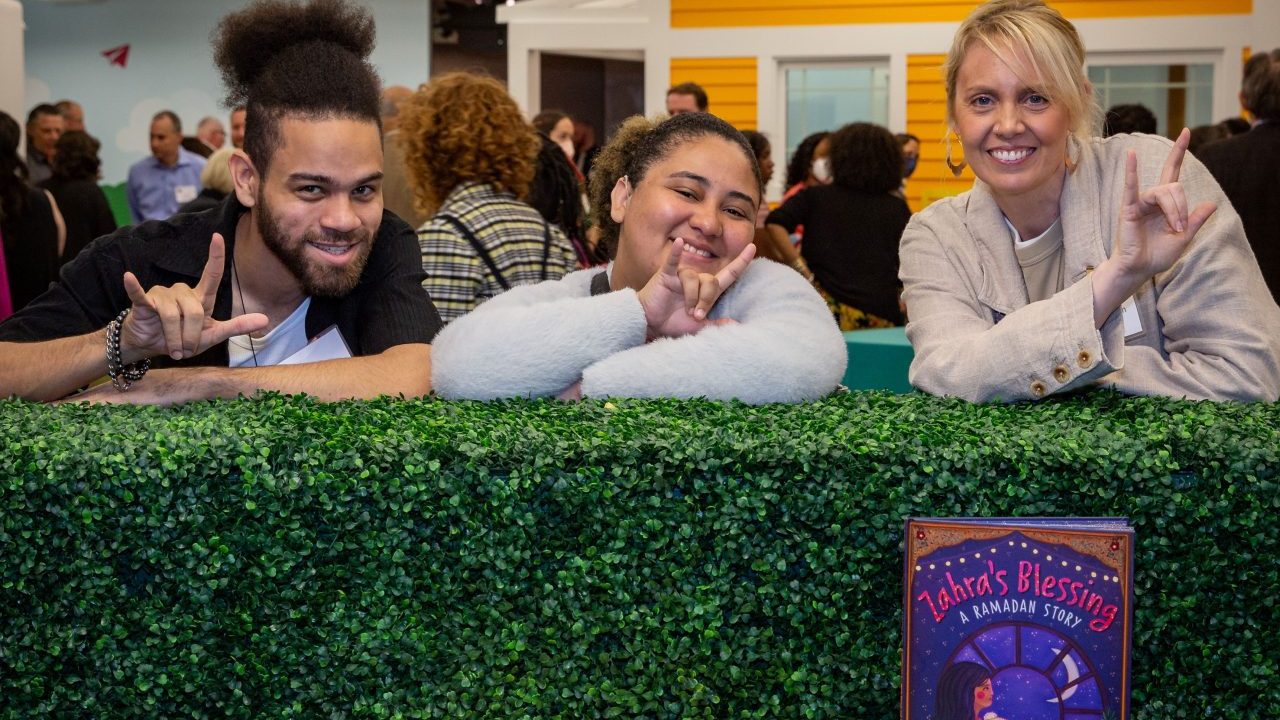
In February 2023, Boston Children’s Museum opened a new exhibition called You, Me, We, which encourages families to connect with each other around questions of fairness in the world, reflect on and express their identities, explore similarities and differences, and build a sense of belonging. Based on feedback from parents and caregivers about their needs, the exhibition offers thoughtful guidance and tools for engaging with children as they begin to perceive, explore, and question topics such as identity, stereotyping, and discrimination.
Both the organization of and the components within You, Me, We were designed to invite and support these family interactions and conversations. The exhibition is organized into three different zones, one for each word in its title. “Me” guides visitors to reflect on their own identities, with components like a self-portrait station with the prompt “What makes you awesome?,” with a backdrop of youth portraits by a local teen group for inspiration. “You” guides visitors to reflect on their interactions with others, with components like a kitchen area where they can watch videos of Boston residents sharing their own family food traditions, while preparing a (pretend) meal that’s meaningful to them. “We” guides visitors to reflect on their ability to work together to create change in their communities, with components like a block set they can use to build the neighborhood they want to live in and a kindness wheel they can spin to receive a kindness challenge to tackle in the museum or at home.
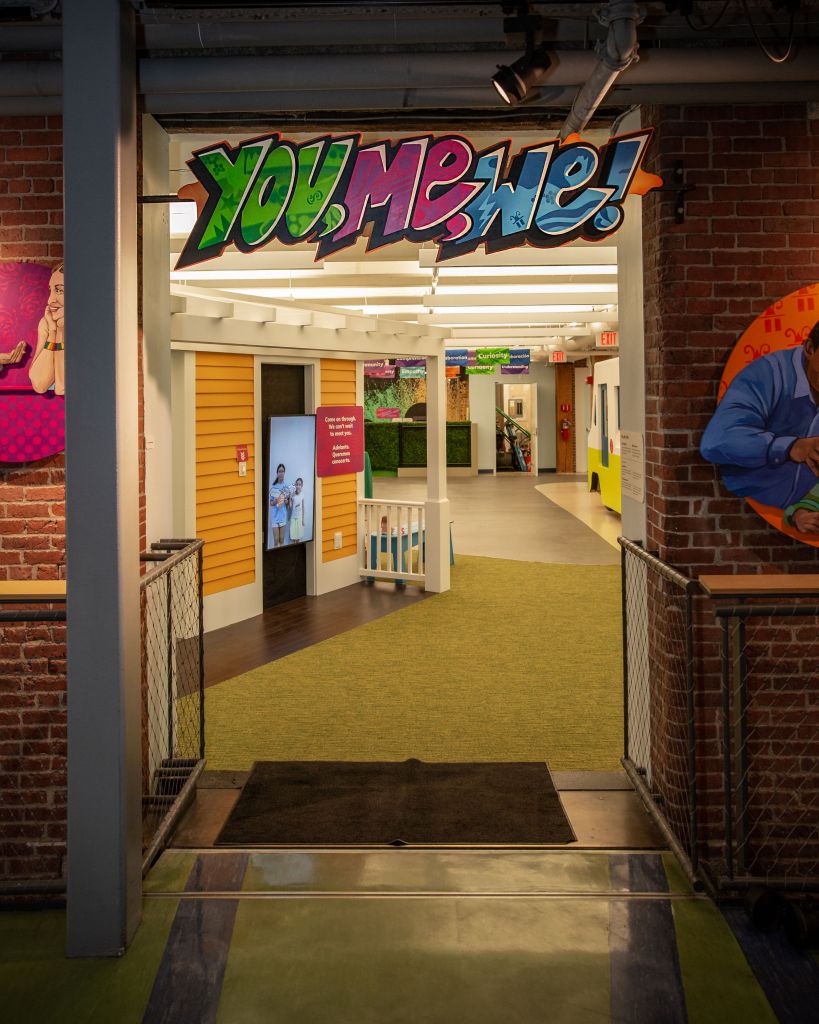
The goals for You, Me, We are lofty, but incredibly important at this moment in time—when notions of a national empathy deficit, acts of hate, and divisions amongst neighbors appear regularly in the news. Supporting the next generation in grappling with these difficult topics is critical work, and we believe museums like Boston Children’s Museum can play a role in tackling it. But doing so requires a careful approach. As with any topic, we must center our organizational identity as a children’s museum first and foremost, addressing these issues in ways that meaningfully engage kids and families, and—despite the seriousness of the issues—do it in a way that brings joy, inspiration, and hope.
For this reason, we were particularly anxious to hear feedback as we opened You, Me, We. We were curious how visitors would feel about the exhibition and what they would take away from it: whether caregivers would react positively, whether visitors would engage in the sometimes-difficult questions being presented, and whether they would feel comfortable in doing so. So we set out to conduct an evaluation guided by four main questions:
- How do child and adult visitors engage with the exhibition components and each other within the You, Me, We exhibition?
- Within the exhibition, do adult visitors feel supported in engaging with their children about issues related to the themes of You, Me, We?
- Within the exhibition, do visitors (children and adults) feel represented and comfortable?
- Has adult visitors’ understanding of and interest in ways to support their children around the exhibition themes increased as a result of their experience with You, Me, We?
The evaluation team conducted its work over the span of approximately one month, starting a few days after the exhibition was open to the public. Their methods included visitor surveys (n=399), visitor counting (n=126), observations (n=143), and interviews (n=94). The team members included the museum’s internal evaluator and six additional museum staff, including one Spanish speaker and one Cantonese and Mandarin speaker, who were able to collect feedback from non-English speaking visitors. To assist any other museums seeking to find the right approach with these themes, we share some of our findings and analysis of future considerations and next steps below.
1. How do child and adult visitors engage with the exhibition components and each other within the You, Me, We exhibition?
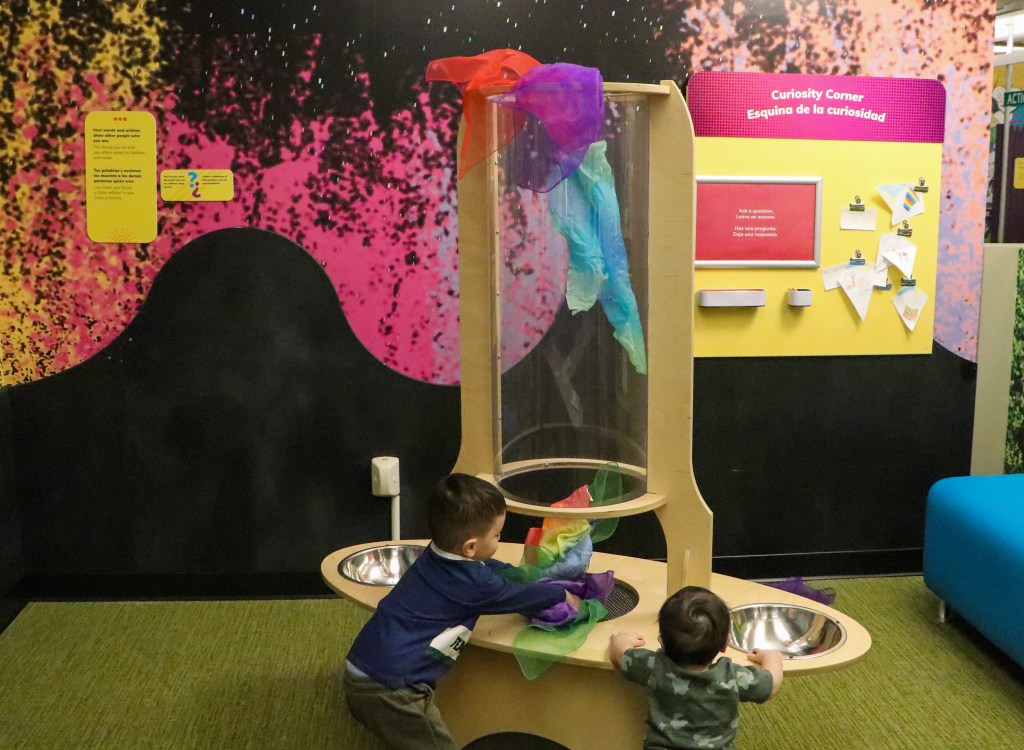
What visitors did or talked about in You, Me, We varied widely, but included actions such as adults and children engaging in play, adults guiding children’s behavior, and adults sitting, observing, and talking together about play or narrating children’s actions. Visitors appreciated exhibition design approaches that offered fun, interesting, and/or interactive play experiences; enabled young children to reach or engage on their own; supported peer interactions with plentiful materials; and provided seating nearby.
One goal of the design of the space was to encourage interaction within and across visitor groups, and preliminary findings around this are positive. More than one third (35 percent) of survey respondents reported having a memorable experience with visitors outside of their own group in the exhibition. These included independent interactions between children (playing and working collaboratively) and interactions between other adults and children together. A survey respondent shared one memorable interaction in the exhibition:
“My daughter worked collaboratively with other children at the Fly a Belief Kite area. The world is currently very anti-rainbow and seeing my daughter working with multiple young boys to make pretty rainbow fabrics fly was very heartwarming.”
2. Within the exhibition, do adult visitors feel supported in engaging with their children about issues related to the themes of the exhibition?
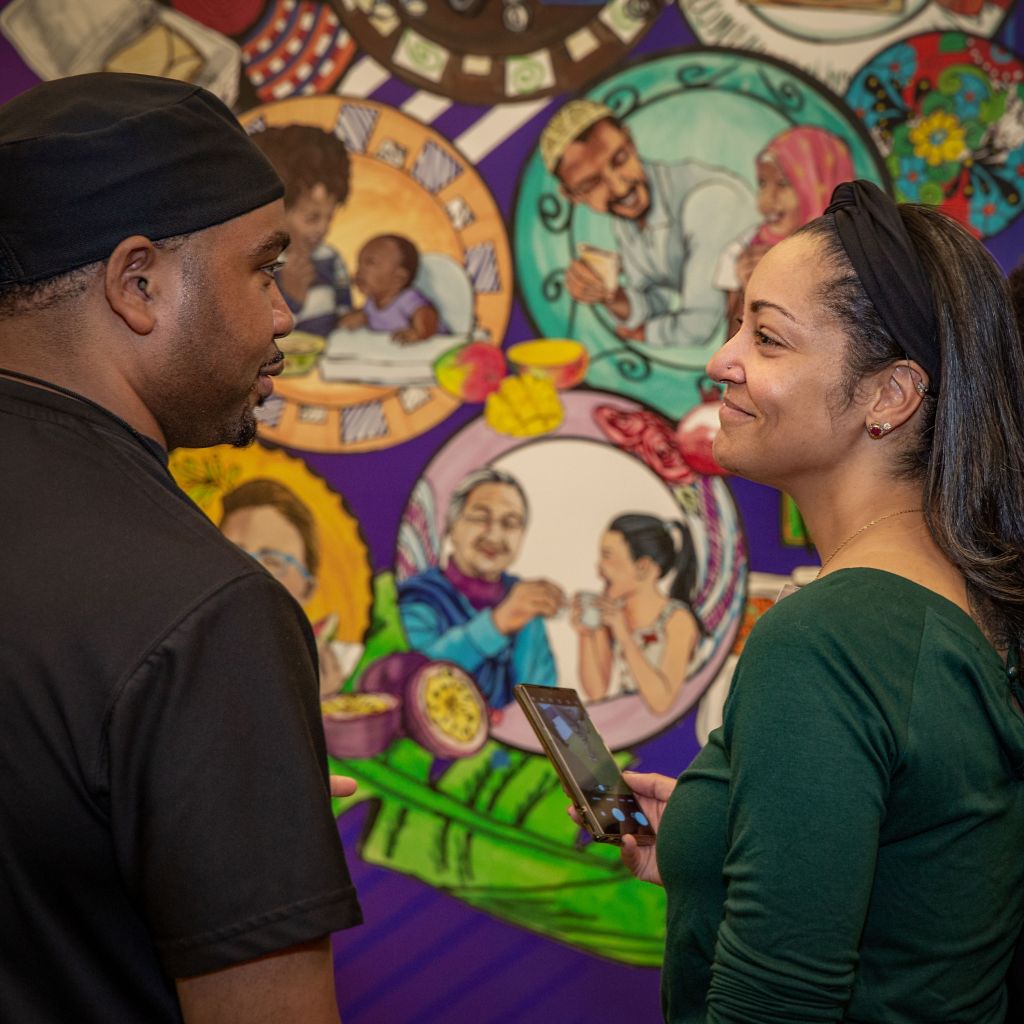
One out of four (26 percent) survey respondents reporting having conversations with their children related to the You, Me, We exhibition themes, which include identity, differences and similarities, belonging, and fairness. They reported feeling most supported in these conversations by the types of play materials available (e.g., cookware and food items in the kitchen) and signs that explained what to do. Specific topics of conversation included discussions related to food or language; to being kind or fair; and to visitors’ general You, Me, We exhibition experience. One survey respondent described having a conversation with their school-aged children about the exhibition themes:
“We talked about being kind and fair and that when you see someone not treating someone with courtesy and respect, it’s OK to speak up. It might make the person who wasn’t respected feel better about themselves and it might make the person who wasn’t respectful be more respectful in the future.”
We also observed firsthand an adult-child pair discussing what it means to be an activist near one of the book corners in the exhibition:
The adult asks the child, “What is an activist?” and later shares a definition with the child. The adult also explains the definition of a community and describes how a community can be built with different cultures and religions.
Then the adult returns to the topic of what an activist is. She gives an example of how anyone can be an activist in a quiet way—for example, if someone is sitting alone, you could just go up and introduce yourself.
The child then asks the adult a question, “So if someone is alone at school, I say ‘Hi’?” The adult responds, saying “Yeah!”
For the other 74 percent who did not have conversations in the exhibition, or did not remember having them, the most common reasons given were that they were “too busy playing to talk,” and that their “child is too young.” Some visitors also felt that children’s museums may not be the right place and time to discuss complex topics such as racism, differences, and community action:
“I agreed with many ideas—but it didn’t seem the time and place for a 4-year-old. We were focused on more basic skills of taking turns instead of identifying similarity and differences of other people. Sometimes I don’t want to put words in her mouth—when the problems of our world are not obvious to her.”
Given the dense and complex themes addressed in You, Me, We, we are considering this finding an excellent starting point to build upon. The museum team is actively developing programs designed to increase conversation in the space and experimenting with play materials we can offer that might further engender thematic conversations.
We are also considering how we can address the concern that some children are too young for these conversations. With slight changes to signage and labels in the space, the museum team might be able to better communicate with caregivers that even very young children can and do notice race, issues of fairness, and identity. Currently, there are already messages related to these ideas, primarily in the infant/toddler area of the exhibit, so we are looking into spreading this messaging better throughout the exhibition space.
3. Within the exhibition, do visitors (children and adults) feel represented and comfortable?
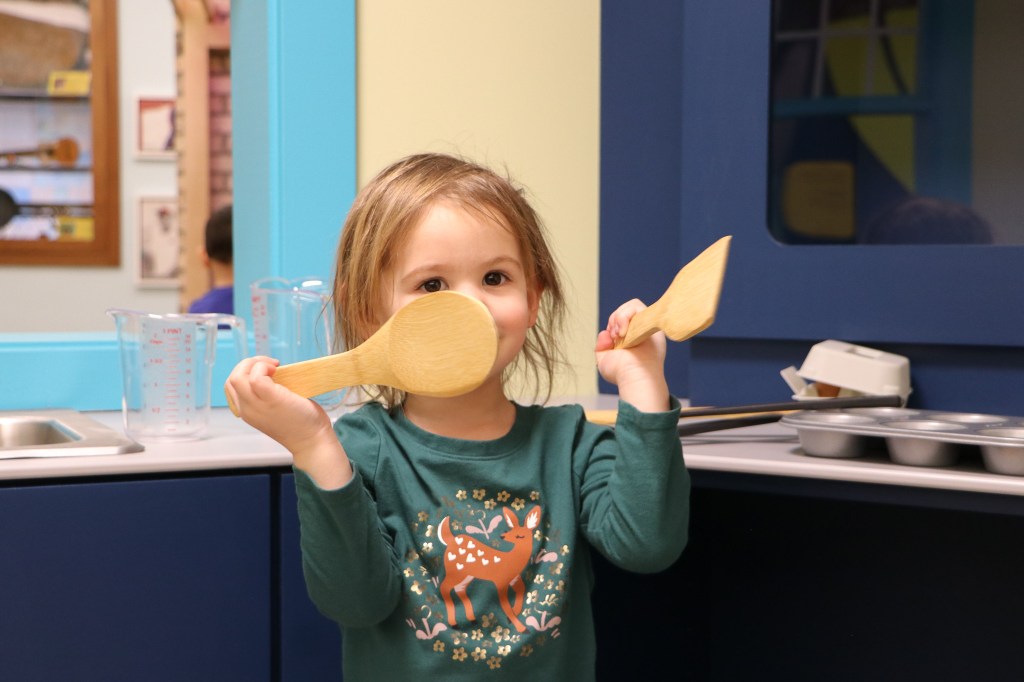
All components in the space—including murals, books, videos, and even baby dolls and pretend food products—were carefully chosen to represent the many races, ethnicities, and identities of our visitors. As a result, 93 percent of survey respondents felt their identities were “mostly” or “somewhat” represented in You, Me, We (with 64 percent indicating “mostly”), citing as helpful the play materials, photos or artwork, and objects from the museum’s collection that were chosen by community members for display in the exhibition. Ninety-six percent of adult interviewees reported feeling welcomed in the exhibition. They indicated several themes that helped them to feel welcomed in the space, including the overall exhibition design, space, or seating; play materials that highlighted You, Me, We themes; bilingual signs; books; and staff or other visitors being friendly. During the in-person interviews, some of the adult visitors expressed a sense of nostalgia when seeing exhibition design elements and play materials that reminded them of their own experiences:
“The [community] garden… I really like it because it reminds me of back home, where we have a community garden.”
“We have grills in our hometown, in our Caribbean culture, I remember how we sometimes grill pigtails.”
Again, this is a very positive finding, which has implications for other spaces within our museum and potentially applicability for other museums. Visitors do notice physical representations of people, languages used, and loose parts in a museum space, and consider whether they may feel an affinity with the identities represented. All of these aspects of exhibition design can potentially be leveraged to create a welcoming atmosphere, no matter the particular themes of a given exhibit.
4. Has adult visitors’ understanding of and interest in ways to support their children around the exhibition themes increased as a result of their experience with You, Me, We?
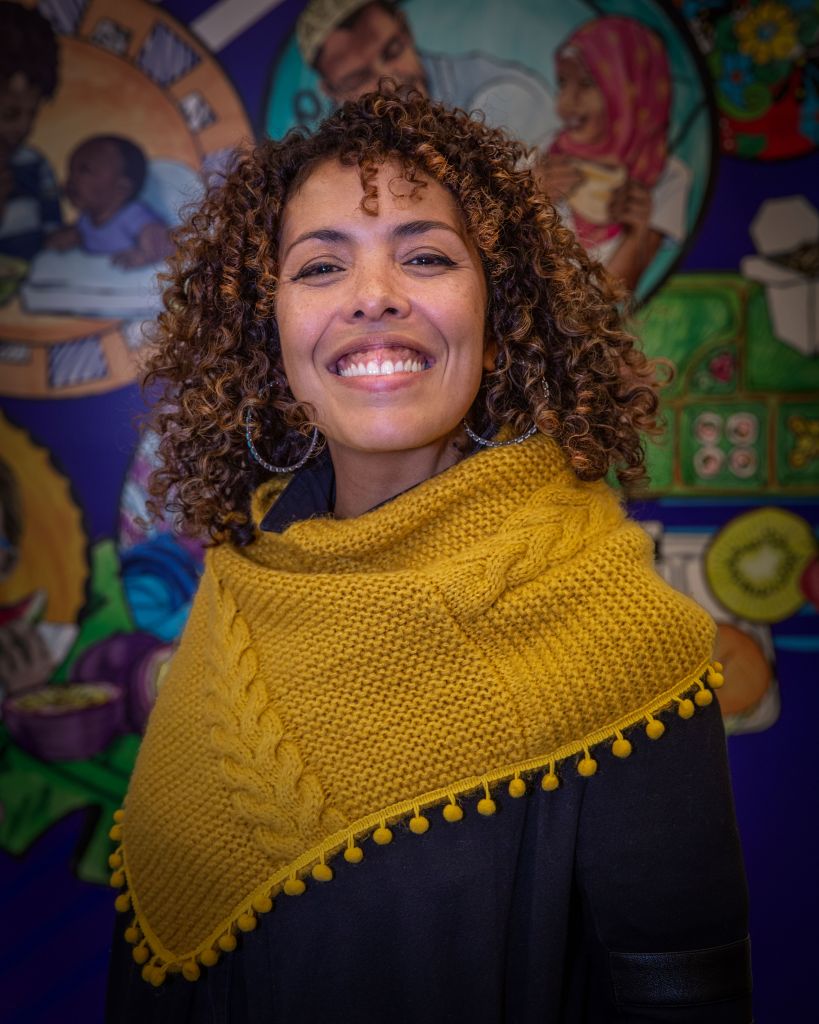
More respondents agreed than disagreed that You, Me, We helped them gain a better understanding of or interest in supporting their children around the themes. However, nearly half of all respondents said they neither agreed nor disagreed with this. This finding could indicate several things, and more investigation is necessary to truly understand visitors’ experience. It might be, for example, that many respondents felt they had a strong interest or understanding before visiting the exhibition and thus their experience didn’t drastically change their personal understanding or interest. Or it could be that the themes in You, Me, We are too complex to deepen understanding and interest within one visit or short engagement. Or it could be something completely different. Future evaluation efforts will continue to probe the reasoning behind these visitor responses, and, particularly, to tease out how visitors with different identities and visit frequency may respond.
For instance, one noteworthy finding was that responses varied when disaggregated by race. Those who self-reported as African American/Black, Asian or Asian American, Latinx/Hispanic, any other race/ethnicity, or two or more races or ethnicities were more likely to respond at either end of the scale for both questions (either agreeing/strongly agreeing or disagreeing/strongly disagreeing), than those who self-reported as white alone. To parse why this is, we will need to conduct additional conversations with visitors.
The reception of any exhibition focused on fairness, disrupting bias, and building empathy for one another will be highly contextual (In what state or region is it being presented? In what type of museum? How is it framed?). And yet, visitor feedback on some of the approaches applied in You, Me, We provides interesting reflection points for all museums. On the positive side, visitors did point to design decisions, play materials, and labels as important to supporting their experience and ability to engage with their children around the exhibition themes. On the negative side, some criticized the exhibition, either because they disagreed with the ideas it presented, felt the museum was not an appropriate space to introduce them, or worried about children being indoctrinated. This range of reactions supports existing research about how visitors see museum environments, on a spectrum from “respite” to “challenge” (see Wilkening Consulting, 2022[1]). Some visitors may see children’s museums as a whimsical space for children and adults to focus on play absent of challenges they may experience in their daily lives.
However, this group of visitors is only part of the audience. Some visitors specifically shared ways in which our approach helped them, and others they love, feel welcomed. For example, a mother shared her experience succinctly in the post-visit survey:
“I brought my baby and met up with our former nanny and her current family. My nanny speaks Spanish and takes the children to the museum often, so it is very important to me that the museum feels welcoming and fun for her. I was glad to see how much Spanish language was posted, it felt inclusive and welcoming.”
We believe that Boston Children’s Museum’s experience, while unique, provides interesting insights that other museums hoping to create exhibitions that might touch on similar topics, especially for children and families, can draw upon. And as we learn and share more about experiences in our museum, we welcome feedback and sharing from other institutions that we can consider.
[1] Wilkening Consulting. (2022, November 15). Museums and Wellbeing, part 2: The respite/challenge tradeoff [Infographic]. https://wilkeningconsulting.com/museums-and-wellbeing-part-2-the-respite-challenge-tradeoff/






